America's Growing Obsession with Bathrooms
-
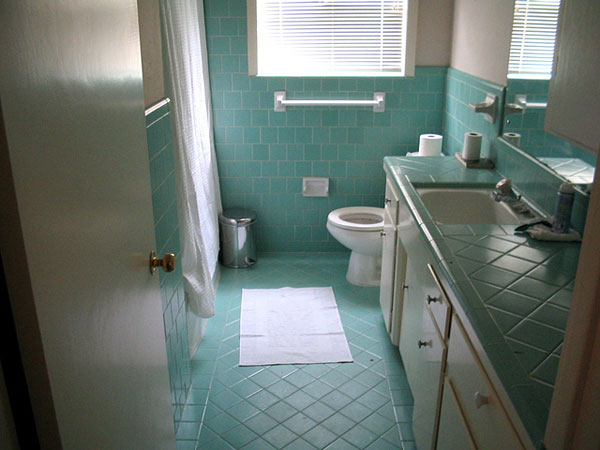 Photograph by flickr.com user "mrbill." Image licensed per CREDIT: Creative Commons Attribution 2.0 agreement, courtesy flickr.com.
Photograph by flickr.com user "mrbill." Image licensed per CREDIT: Creative Commons Attribution 2.0 agreement, courtesy flickr.com.The three-bedroom bungalow that my parents bought in 1956 would be considered small by today's standards: only about 800 square feet. It had a single bathroom. Strictly no-frills, the bathroom had a basin, a tub, and a toilet, a built-in toothbrush holder, and ceramic tile halfway up the wall. We thought it the height of luxury.
-
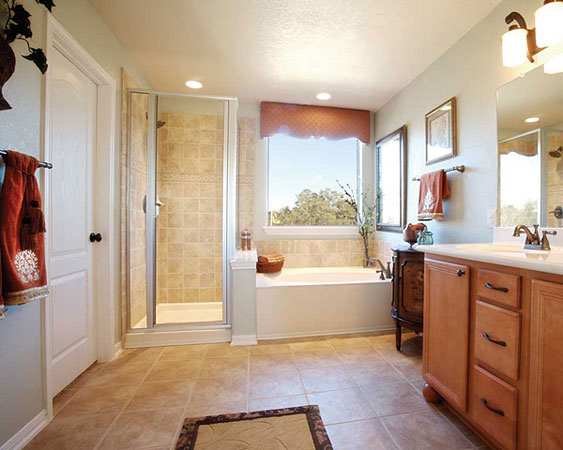 Model bathroom for Trails at Herff Ranch development, Boerne, Texas. Image courtesy KB Home.
Model bathroom for Trails at Herff Ranch development, Boerne, Texas. Image courtesy KB Home.Today, the old-fashioned three-fixture arrangement of the 1950s has become so rare that some builders are calling it a
"¾ bathroom." Bathrooms are now expected to have a glassed-in shower stall in addition to a tub, and many feature "his and hers" sinks. (The bathroom on the right is from a Texas development where modestly priced houses sell for between $170,000 and $250,000.) Modern bathrooms now have stone and marble tiles instead of turquoise or pink mosaic, and bronze and brushed stainless steel instead of shiny chrome. Increasingly, the toilet is located in a separate compartment—a sensible and hygienic practice imported from Europe, but one that also makes the bathroom appear less simply functional. This is definitely not your grandfather's loo. -
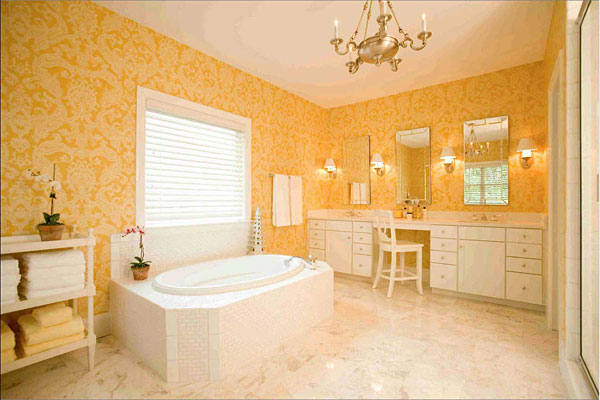 Model bathroom for Hampton Oaks development, Fairburn, Ga. Image courtesy KB Home.
Model bathroom for Hampton Oaks development, Fairburn, Ga. Image courtesy KB Home.Perhaps the most striking change affecting America's formerly utilitarian bathroom is the advent of decor. The room at right, from a model home outside Atlanta, is a bizarre combination of Victorian boudoir (the boldly patterned wallpaper), Hollywood glamour (the oval tub), and Elsie de Wolfe chic (the white furniture). This model is from the second in a series of planned communities built by KB Home, one of the nation's leading builders, with the collaboration of Martha Stewart. The houses are priced from roughly $200,000 to $400,000; the exteriors are said to be based on Stewart's own homes, in Connecticut, Maine, and Long Island, although it's hard to imagine the homemaking expert in this rather theatrical setting.
Correction, Jan. 18, 2007: This article originally misidentified the Hampton Oaks development in Fairburn, Ga., as the seventh community built by KB Home in collaboration with Martha Stewart. In fact, it is the second.
-
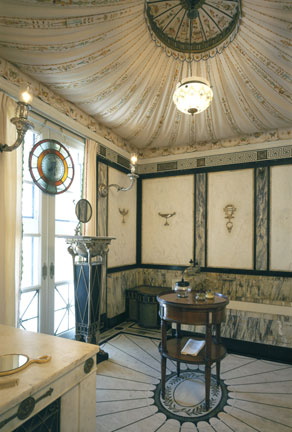 James Deering bathroom, Vizcaya Museum, Miami, Fla. © Steven Brooke Studios.
James Deering bathroom, Vizcaya Museum, Miami, Fla. © Steven Brooke Studios.Of course, fancy bathrooms are hardly new. When Chicago industrialist James Deering built Vizcaya (1912-16), an Italian baroque mansion that became his spectacular winter home in Miami, money was no object. His own bathroom, while not huge, was given pride of place, opening onto a loggia in the center of the main facade. The shaving stand opposite the French doors was fitted with a built-in sink that allowed him to look out over Biscayne Bay as he shaved. The inlaid marble bathtub had the proverbial gold-plated faucets, four of them, since they supplied seawater as well as fresh.
-
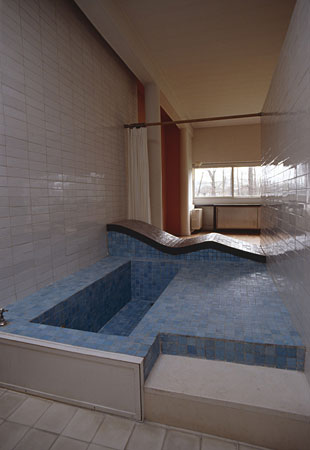 Bathroom at Villa SavoyeCREDIT: © Martin Jones/Arcaid/Corbis.
Bathroom at Villa SavoyeCREDIT: © Martin Jones/Arcaid/Corbis.Early modern architecture was touted as being less cluttered than its predecessors, but when it came to bathrooms, the machine-for-living crowd did not scrimp. Although Charles Jencks has characterized the Villa Savoie (1928-31), Le Corbusier's iconic weekend house outside Paris, as a "heroic health camp," the owners were hardly roughing it. Each of the three bedrooms on the main floor had its own bathroom, and there was also a hall toilet that served as a powder room (the servants' bathrooms were below). The most dramatic bathroom, off the master bedroom, is tall and skylit. The built-in sunken tub looks a little too rectangular to be comfortable. But that lack is made up for by the easeful chaise longue. The bathroom is not large, but it feels spacious since it opens onto the bedroom. The sinuous chaise provides a hint—though only a hint—of indolence. One can imagine a reclining Mme. Emilie, swathed in a bathrobe, sipping a kir.
-
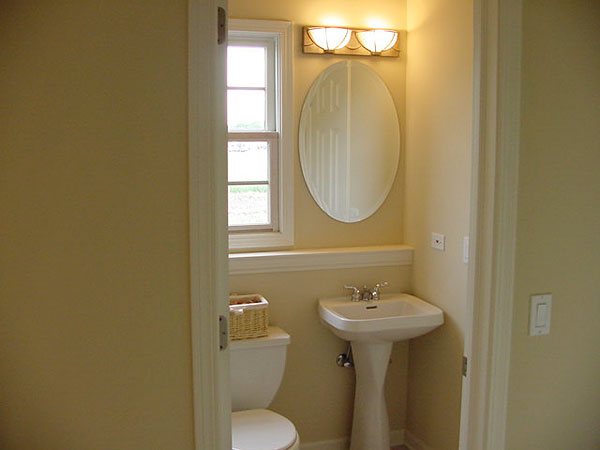 "Aspen" model home. Image courtesy Homes By Strahanoski, Lockport, Ill.
"Aspen" model home. Image courtesy Homes By Strahanoski, Lockport, Ill.The Savoie's bathroom was connected to their bedroom, in the mode that builders today call "en suite." This arrangement, which was once common only in very expensive residences, has trickled down to middle-class homes. In 1973, new houses with one bathroom, or a bathroom and a powder room, still accounted for 40 percent of the total; by 2005, the fraction had fallen to only 4 percent. Today, according to the National Association of Home Builders, the overwhelming majority of new houses have a bathroom attached to the master bedroom and a second bathroom down the hall for the kids, as well as a powder room downstairs for guests. Nearly 50 percent of all new houses have four or more bathrooms, and it is nearly impossible to sell a new house with only one bathroom. While social critics tut-tut this sanitary inflation, it's easy to understand the functional reasons for it: convenience and privacy. No more early-morning family lines; no more tripping over rubber ducks; no more guests snooping in the medicine cabinet.
-
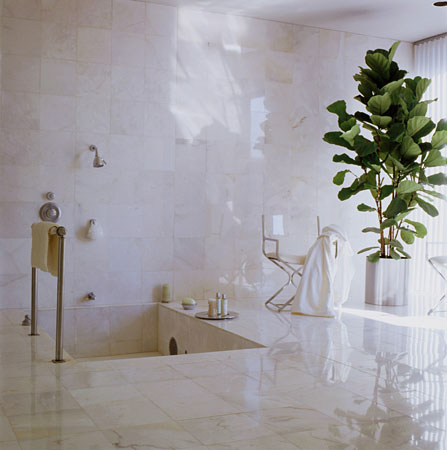 © Scott Van Dyke/Beateworks/Corbis.
© Scott Van Dyke/Beateworks/Corbis.If there are more bathrooms in American homes today than ever before, they tend to be less showy than their early-20th-century predecessors. In architecturally designed custom homes, they are often downright Spartan—as if their owners were fearful of appearing excessive. Minimalism is the byword, although you rarely see anything as plebian as ceramic tile. Marble is the preferred material, the more of it the better. The effect is luxurious but curiously undomestic, more like an upscale spa than a home. If you sipped anything in this room, it would be Perrier—but you'd have to place the bottle on the floor, next to the soap and shampoo. The influence of health spas is also present in the popularity of whirlpool baths. Jacuzzis, like granite counters in kitchens, or a wet bar in the family room, have become features that home buyers can't do without.
-
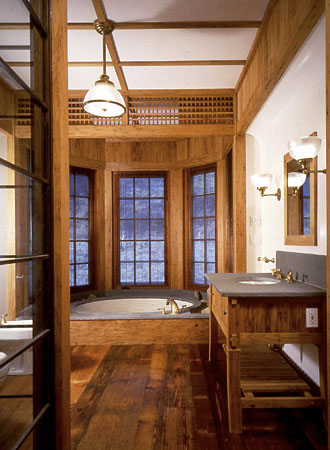 Image courtesy Allan Greenberg Architect, LLC and Tim Buchman Photography.
Image courtesy Allan Greenberg Architect, LLC and Tim Buchman Photography.For some, marble may carry the connotation of an ancient Roman bath, the formality and pomp of which are at odds with modern casual lifestyles. Wood, on the other hand, creates a warm, informal atmosphere that recalls Nordic saunas, Japanese wash-houses, and California hot tubs. This homey version of minimalism seems more virtuous and less obviously luxurious, like organically grown wine or unbleached cotton.
-
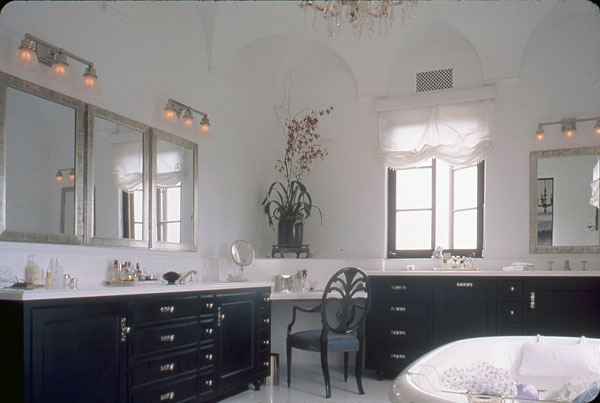 Appleton & Associates, Inc.—Architects. Interiors by Patti Skouras.
Appleton & Associates, Inc.—Architects. Interiors by Patti Skouras.A current trend in bathroom design treats the bathroom as an intimate room rather than as a place to display ceramic ware. The fixtures are designed to resemble pieces of freestanding furniture, which just happen to have been moved in and placed against the wall. There is a feeling of improvisation rather than organization. No walls of mirrors here. This approach recalls an earlier period, when indoor plumbing was first introduced into English country houses at the end of the 19th century, and dressing rooms and spare bedrooms were pragmatically converted into bathrooms. These spaces often had fireplaces, large windows, and room for an easy chair or a chest of drawers. This was not particularly efficient, but it was cozy.
CREDIT: Photograph by Alex Vertikoff. -
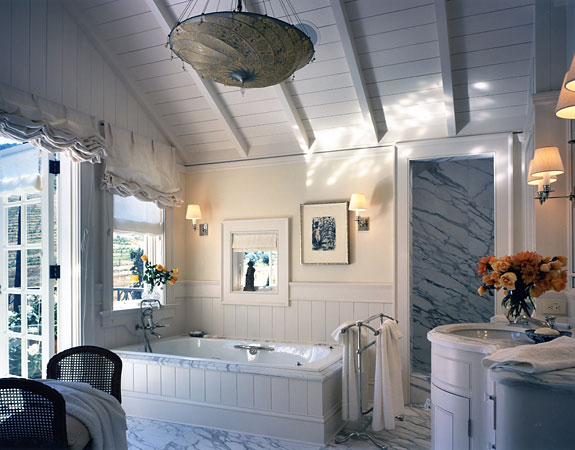 Appleton & Associates, Inc.—Architects. Interiors by Babey Moulton Jue & Booth
Appleton & Associates, Inc.—Architects. Interiors by Babey Moulton Jue & BoothWhy did the bathroom become a focal point in the American home? Different explanations have been given: status-seeking, sybaritic self-regard, reckless extravagance. All can be argued, but why be so Puritanical? The commodious bathroom is less a symbol of wealth than an indulgence of wealth. If you can afford it—and obviously many Americans can—why not make the place where your day begins and ends as comfortable and pleasing as possible? I would add a bookshelf to this particular bathroom, but otherwise it's about as nice as it gets.
CREDIT: Photograph by Alex Vertikoff.